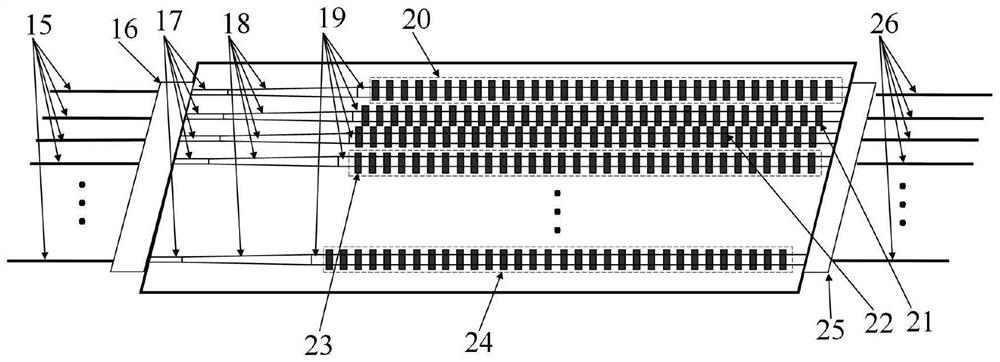Ultra-wide frequency tuning quantum light source chip based on type-II parameter down-conversion
A parametric down-conversion and frequency tuning technology, applied in the field of quantum information technology and nonlinear optics, can solve the problems of low wavelength tuning ability, single use, and inability to continuously cover visible light and communication bands.
- Summary
- Abstract
- Description
- Claims
- Application Information
AI Technical Summary
Problems solved by technology
Method used
Image
Examples
Embodiment 1
[0053] Embodiment 1: the pump light is a fixed-wavelength laser, such as when the wavelength is 454nm, the tuning curve of the change of the polarization period to the wavelength of the class II parametric light is given by image 3 Reflect, the abscissa is the wavelength of the parametric light (nm), and the ordinate is the polarization period (μm). The blue curve in the figure represents the wavelength tuning of the o-polarized parametric light, and the yellow curve represents the wavelength tuning of the e-polarized parametric light (in order to simplify the description , to illustrate here, the abscissa in all the figures in the embodiments is the wavelength of the parametric light, the blue curves are o-polarized light, and the yellow curves are e-polarized light). The polarization period of the degenerate point (corresponding to the wavelength of the parametric light is 908nm) is 2.664μm. Depend on image 3 It can be obtained that the polarization period increases from ...
Embodiment 2
[0056] Embodiment 2: When the fixed wavelength of the pump light laser is 635nm, the change of the polarization period is to the tuning curve of the wavelength of the II type parametric light by Figure 9 , Figure 12 and Figure 13 Reflect, the ordinate is the polarization period (μm), the polarization period of the degeneracy point (corresponding to the wavelength of parametric light is 1370nm) is 6.264μm, since the tuning curve at this time has no minimum period point, so the degeneracy point is set as the starting point Initial polarization period Λ 0 = 6.264 μm. It can be seen from the figure that the polarization period is reduced from 6.264 μm to 5.7 μm (the polarization period increment is ΔΛ=5.7-6.264=-0.564 μm), and the wavelength of the type II parametric light can continuously cover the band from 920nm to 2050nm; for comparison , Figure 10 and Figure 11 They are the wavelength tuning curves of the change of the polarization period to the type I parametric li...
Embodiment 3
[0059] Embodiment 3: When the pumping light is a tunable laser, the curve of the pumping light wavelength changing to tune the wavelength of the II parameter light is given by Figure 16 and Figure 17As shown, the ordinate is the pump light wavelength (nm), the polarization period is 410nm→820nm (the polarization period of the degenerate point) 1.944μm (single-period polarization structure), that is, when the pump light is At 410nm, degenerate photon pairs with a wavelength of 810nm can be generated, and when the wavelength of the pump light is adjusted from 410nm to 412.5nm (the wavelength of the pump light varies by 2.5nm), the wavelength of the output II parameter light can continuously cover the band from 610nm to 1260nm range, that is, continuous coverage from the visible light band to the near-infrared band. When the wavelength of the pump light is adjusted from 400nm to 412.5nm, the wavelength of the output II parameter light can continuously cover the range of 520nm ...
PUM
| Property | Measurement | Unit |
|---|---|---|
| length | aaaaa | aaaaa |
| width | aaaaa | aaaaa |
Abstract
Description
Claims
Application Information
 Login to View More
Login to View More - R&D
- Intellectual Property
- Life Sciences
- Materials
- Tech Scout
- Unparalleled Data Quality
- Higher Quality Content
- 60% Fewer Hallucinations
Browse by: Latest US Patents, China's latest patents, Technical Efficacy Thesaurus, Application Domain, Technology Topic, Popular Technical Reports.
© 2025 PatSnap. All rights reserved.Legal|Privacy policy|Modern Slavery Act Transparency Statement|Sitemap|About US| Contact US: help@patsnap.com



